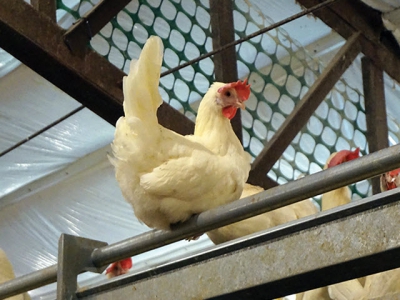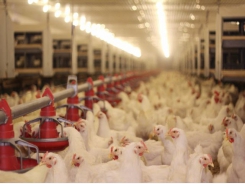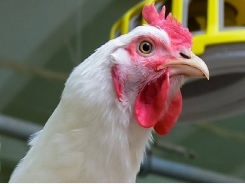Economic challenges of converting to cage-free eggs

An economist looks at some of the challenges the US egg industry faces as cage-free purchase pledges from major retail and food service customers loom on the horizon.
Photo by Austin Alonzo
The number of eggs consumed per person has to do with the retail price of the product. When consumers are presented with various prices of eggs, they tend to choose the lowest-priced option, explained Maro Ibarburu, business analyst, Egg Industry Center. “This is the reason why conventional eggs are still 84 percent of the market,” he said.
The U.S. has one of the world’s lowest egg production costs, according to 2016 International Egg Commission statistics. This cost-advantage has helped the U.S. maintain egg exports of 3 to 5 percent of production annually. This helps maintain prices when U.S. consumers are not keeping up with the amount of eggs being provided on retail shelves.
A relatively small change in supply can result in a large change in price. Ibarburu told the audience at the Midwest Poultry Federation Convention that egg exports help reduce the magnitude of wholesale egg price swings. “Thankfully, after last year in 2017, we are coming back to a normal trade situation,” he said.
Since cage-free eggs are costlier to produce, if the U.S. egg industry converts to cage free, then it will lose its low-cost position in the world market. This means that the typical U.S. egg export volume will decrease.
Ibarburu projected that there would be 5 to 6 million more layers in the U.S. at the end of 2018 than at the start of the year. This will depend on market conditions. From 2011 to 2014, the industry saw an increase in flock numbers like what Ibarburu predicts this year.
Another thing to ponder when analyzing the change in production is the productivity level of each layer. Every year, we are increasing the productivity of a layer about 1.1 egg in a lifetime, Ibarburu explained. Molt and age also effect the U.S. flock average performance.
Impact of the housing situation, going forward
Stating late in 2015, many restaurant chains and retailers announced they would shift their egg purchases to 100 percent cage free by some future year, generally by 2025 or 2026. Some egg producers are now committed to going 100 percent cage free. A total of 223 million cage-free layers will be needed by 2026 to meet the purchase pledges. The industry is currently transitioning to a cage-free industry at about half the rate that would be needed to meet the pledges by 2026, Ibarburu explained.
In the last two years, 21.4 million layers have been transitioned to cage free; to reach the 2026 goal, producers would have to transition 21.5 million a year for the next eight years. We could end up with a surplus of cage-free eggs until 2026, said Ibarburu, even if the pledges are honored.
Producers may experience higher mortality rates, lower eggs per hen housed and poorer feed conversion rates in a cage-free system, Ibarburu noted. In short, cage-free eggs have a larger environmental footprint than cage-produced eggs. “For the pledges [to be met], we will need another 118,000 acres to supply the corn and soybean meal that we need to feed these birds,” said Ibarburu.
Demand for cage-free eggs varies in different areas of the country. “Higher proportion of cage-free eggs are sold either on the West Coast or the East Coast; the lowest proportion of cage free is sold in the Midwest and south-central regions of the country,” said Ibarburu. Retailers will have to come up with a marketing plan for customers to buy the more expensive option. “This will really take some creativity and research,” Ibarburu added.
Potential health risk
A potential risk for cage-free systems is poultry red mites. This harmful mite is extremely costly to the poultry industry; annual European industry losses alone are at EUR360 million (US$446.54 million). This is an issue that has not yet impacted the U.S.
Another possible issue producers may encounter in a cage-free system is floor eggs, which may create a food safety risk because of contamination to the shell. High incidences of featherless areas, skin lesions and keel bone damage will need to be addressed in managing cage-free systems, Ibarburu also mentioned.
Cost of production
To make this transition, producers will be challenged with the estimated cost of building cage-free facilities, which will ultimately be reflected in the price of eggs for consumers. The estimated cost of building cage-free houses to meet the 2026 goal is about US$11 billion. “That doesn’t include costs associated with building completely new sites, which will be more expensive with moving dirt, permitting, bringing electricity, feed mill, egg processing and other factors,” explained Ibarburu.
For producers to invest in cage-free production, they are looking at both a higher capital cost and higher operating cost. “Most of the time, when you are investing in your facility, it is because you want to either reduce your operating cost by becoming more efficient or because you have a new product that consumers are willing to pay a premium for,” said Ibarburu. If producers don’t get a premium for cage-free eggs prior to all the purchase pledges being fulfilled, it could be a very costly transition.
About 76 percent of the pledges for 2026 comes from grocers. “This is a challenge because grocers give their customers choices and consumers tend to choose the lower price,” said Ibarburu. Until grocers are 100 percent cage free, it will be harder to capture those higher premiums.
A higher proportion of cage-free eggs is sold on the West Coast and the East Coast; the lowest proportion is sold in the Midwest and South Central regions of the country.
Related news
Tools

Phối trộn thức ăn chăn nuôi

Pha dung dịch thủy canh

Định mức cho tôm ăn

Phối trộn phân bón NPK

Xác định tỷ lệ tôm sống

Chuyển đổi đơn vị phân bón

Xác định công suất sục khí

Chuyển đổi đơn vị tôm

Tính diện tích nhà kính

Tính thể tích ao




 Egg producers discuss cage-free production challenges
Egg producers discuss cage-free production challenges  Salmonella outbreaks could fuel push to cut antibiotics
Salmonella outbreaks could fuel push to cut antibiotics